While I enjoy writing about wine and use it as much as a teaching tool for myself as well as others, I’m sometimes hesitant to write about famous wine families or other well-known topics. I always think, “what more can I add?” But then I have to remind myself that if it’s new to me, then it’s likely new to some of you as well. So when I participated in my latest virtual wine dinner (and do try these if you’re able as they can really be such a fun way to interact with others) from local restaurant Roma, I again felt that hesitation.
Our virtual guest for the evening was Stefano Cinelli Colombini, owner and winemaker (who represents the 20th generation!) of Fattoria dei Barbi and folks were pretty excited about it. Fattoria dei Barbi is practically synonymous with Tuscany so the excitement was certainly warranted. While I was familiar with the family crest on the blue label that I’d seen on a number of bottles, I didn’t quite appreciate the significance of the family and definitely didn’t have much experience with their wines. But after an engaging dinner with Stefano where he shared much about his family’s history in Tuscany, I decided that this was a story I wanted to share. I mean if you have a saint in the family, are responsible for one of the region’s most famous salads, and have one of the most recognized Brunellos in the world, your story is certainly worth sharing! If folks want to expand their horizons and experience the (wine) soul of a place, who better than from one of the pioneers and stewards of a place?
Some Tuscany Background
First things first – when we’re talking Tuscany, we’re talking Sangiovese. You know, that variety that they make Chianti with? And though there are numerous Sangiovese clones that affect things from color to aromatics to tannin, we’ll just stop at the fact the Sangiovese is the primary variety of the region. Italy, and Sangiovese in particular with its 10,000 names, is always complicated so let’s not make it worse! But if you’re curious, do check out my sometimes frustration with Sangiovese and its many names.
Outside of the traditional historic zones, you encounter more international varieties such as Cabernet Sauvignon, Merlot, and Syrah which are key components of the so-called “Super-Tuscan” wines. Outside of the reds, white wines are made with Trebbiano, Malvasia, and Vernaccia as far as indigenous varieties are concerned, while Chardonnay and Sauvignon Blanc crop up for non-traditional varieties. But without a doubt, red wine reigns supreme when it comes to Tuscany.
A Storied Existence
And Fattoria dei Barbi has certainly had a hand elevating the status of the region’s red wines. The Colombini family has owned land in Montalcino since the mid 1300s, acquiring the Fattoria dei Barbi estate in 1790. It is one of the most prestigious and historic estates in Tuscany and is one of a handful of estates that has operated continuously over 100 years. Surprisingly, given the prestige, the wines are generally in the affordable range. This is particularly true when we think about so-called top wines of Napa or Sonoma where the prices could be two or three or even four times the price.
An estate as storied as this one certainly has a host of ‘firsts.’ While not THE very first, they were ONE of the first to produce Brunello. They were the first in Montalcino to export bottled wine to France and theirs was the first Brunello to be imported into the United States. They were the first to open their cellars (which is just as much a museum, if not more, than tasting room) to the public in 1946 and were actually the first to create a ‘Super Tuscan’ in 1969. Additionally, they are one of three original producers that joined the Brunello consortium in 1967. Like I said, lots of firsts and certainly great stewards.
There’s a Saint in the Family
In addition to putting Brunello on the world map, the family also has a few other claims to fame. The ancestry, dating back to the 14th century, shows a saint (well almost saint – apparently he was beatified which is one step from canonization as a saint) in the family, the Blessed Giovanni Colombini. He even created his own religious order – the Congregation of Jesuati. And it was because of his deeply religious beliefs and vow of poverty that we got the beginnings of panzanella, which is the classic bread salad of Tuscany.
When he took his bow of poverty, Giovanni gave up everything, which was a bit of a sacrifice as the family was one of means. I almost spit out my wine laughing when Stefano declared the whole thing a “disaster.” Apparently while it was good for the poor, not so much for the family. But the family ultimately recovered and was able to rebuild their wealth.
Now, the salad part of the tale comes from the fact that Giovanni fed the poor (and himself) with whatever scraps of food he could find. On one occasion, he used olive oil that he squeezed with own hands from the olive trees to toss with some leftover bread and garden herbs and vegetables. Hence the beginnings of this very famous salad.
Dinner with Stefano
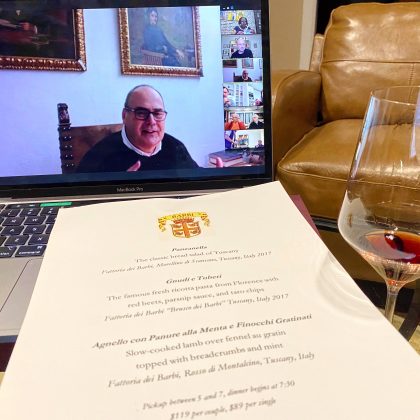
And so the dinner went with fascinating tales and compelling history from Stefano. His passion and pride when he shared the history of the region and his family story was certainly palpable and made for quite an engaging dinner.
Here’s what we had for Dinner.
Panzanella Salad + 2015 Fattoria dei Barbi Morellino di Scansano (~$25)
This wine comes from the south Tuscan coast in Maremma and is comprised of 85% Sangiovese and 15% Merlot. ‘Morellino’ is the local name for Sangiovese in Maremma and is usually drunk young. But folks have certainly been known to age them a bit. Because of the warmth in the region, the wines tend to be soft and round, somewhat reminiscent of wines from southern Italy. The warmer temps also means these wines tend to be higher in alcohol, so be careful when you’re imbibing on an elegant and easy-going sipper such as this one. And I’m told that 2015 is considered one of the best vintages of the century.
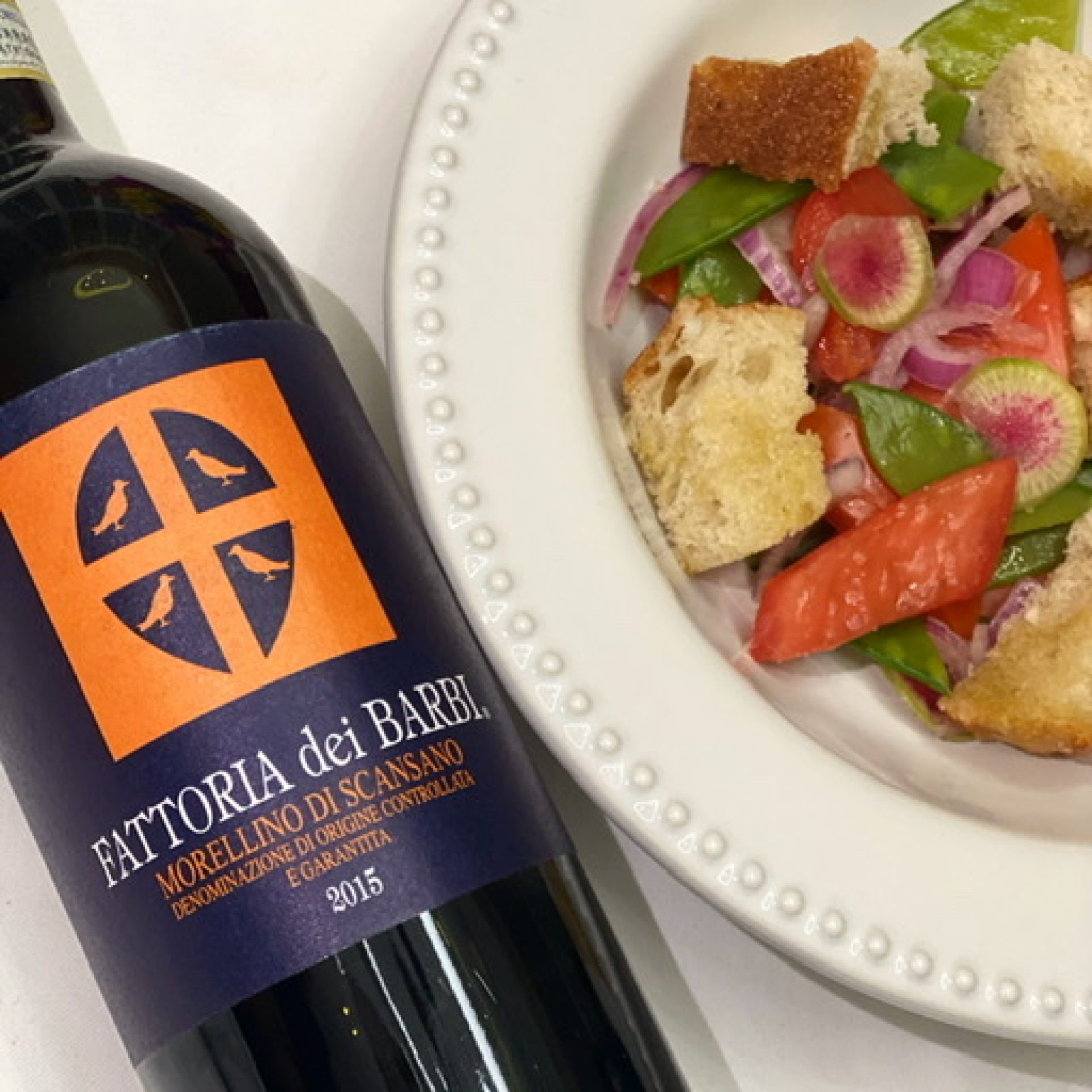
We paired the wine with a panzanella salad – my first! But I’d seen so many panzanella salads on the show Chopped (one of my favorite pastimes with Thing 2) that I was seriously on the verge of trying my hand at it. For real! I was a little skeptical about pairing this wine with the salad as I thought it would overpower it. But the wine still packed considerable acidity and its hint of green notes (olives and shrub) along with fresh cherry made for a nice pairing.
Gnudi e Tuberi + 2016 Fattoria dei Barbi Brusco dei Barbi (~$25)
Our second wine was the Brusco dei Barbi, which is 80% Sangiovese and 20% Merlot. In creating the Brusco dei Barbi, Stefano shared that his grandfather Giovanni (a different ‘Giovanni’ than our saint friend above) wanted to create a wine that could be drunk with his beloved pecorino cheese but also had a desire to create a different type of “top” wine, an important wine. The wine is sourced from the family’s property in Maremma, near the coast of the Tyrrhenian Sea and is named for a sort of “highway man” or “Robin Hood” that lived near the family’s estate. Now of course, I’m abbreviating the story, but there was a lot more to it including some lady named Rosa and somebody being shot! A fresh, young wine, that is never aged in wood and made to be approachable, it’s like a 3rd wine of the portfolio behind Brunello and Rosso. This is a softer style of wine with rich fruit and can definitely appeal to a more “American palate” but its still a Tuscan wine through and through.
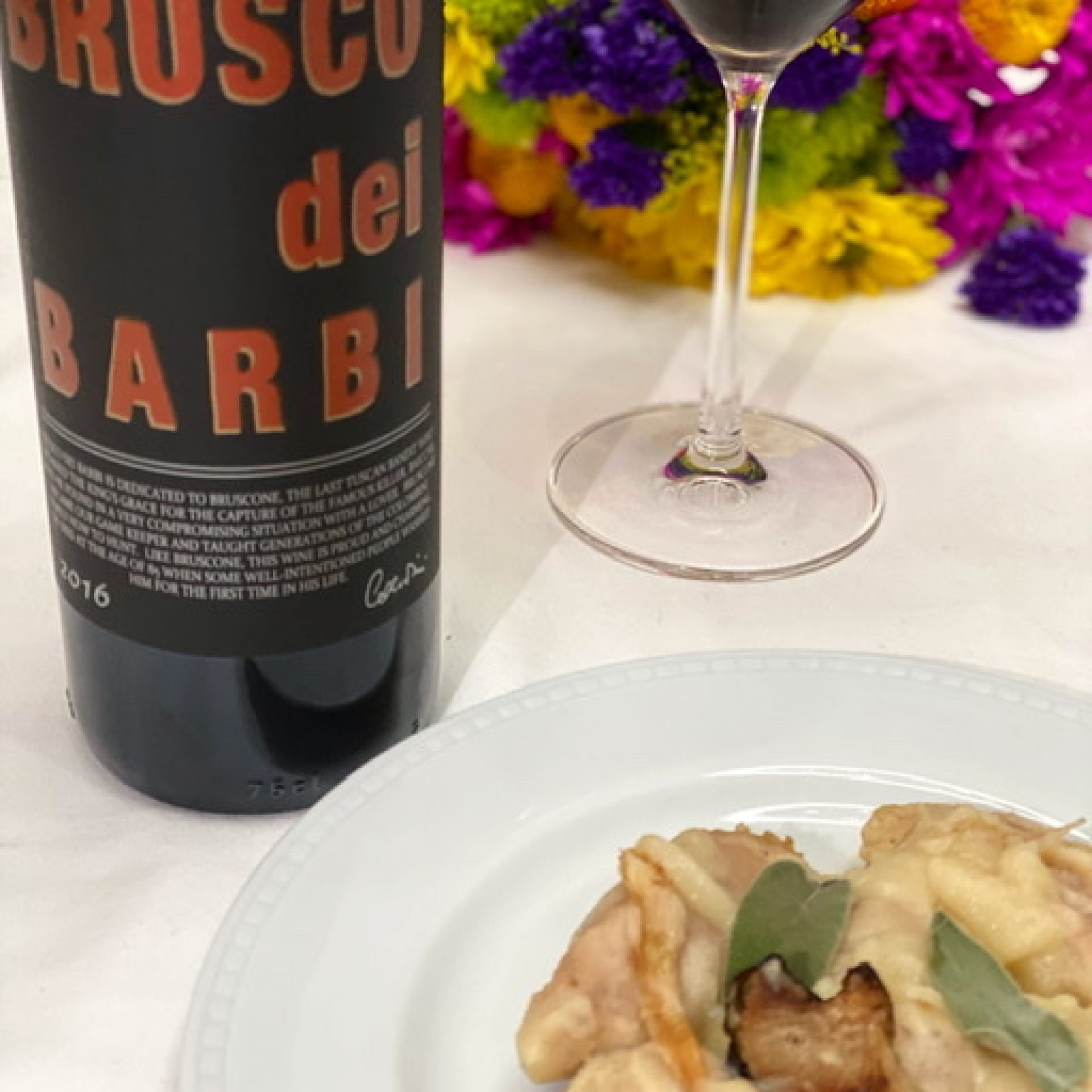
We paired the wine with gnudi e tuberi, which is a fresh ricotta pasta from Florence with red beets, parsnip sauce, and taro chips. The freshness of the wine certainly complemented the richness of the dish. I’d also love this one with pizza. Lots of bright, fresh cherries, along with a touch of spice and earth.
Lombo D’agnello con Panure alla Menta e Finocchi Gratinati + 2017 Fattoria dei Barbi Rosso di Montalcino (~$36)
Our third wine of the night was a Rosso di Montalcino, which is a “second” wine to Brunello and like Brunello is crafted of 100% Sangiovese and is from Montalcino. But do be careful what you call it. Winemakers and Italian wine experts absolutely bristle at the reference of these wines as “Baby Brunello.” That’s because, Rosso is very much an intentionally made wine that stands on its own. While many revere Brunello, I many times actually prefer Rosso.
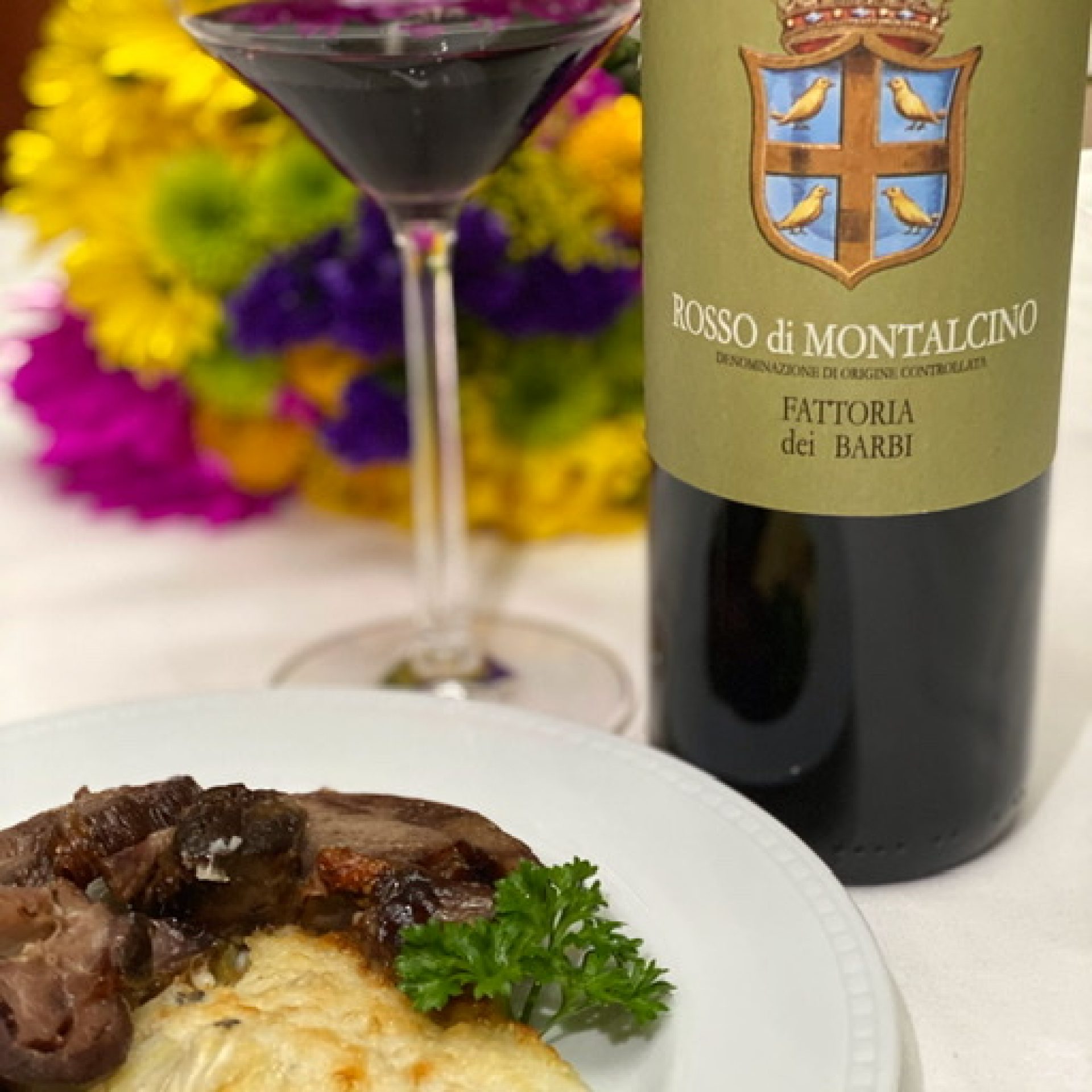
So what’s the difference if they are both Sangiovese wines from Montalcino? Particularly in this case, when the fruit of the Rosso comes from the same vineyard as Brunello. Well, Montalcino is a hill town with different altitudes and aspects which produces Sangiovese with different characteristics. Some of the wine is more tannic which is better for Brunello with its longer aging requirements. At the end of the day, it’s not worse, rather just different. Do you want to drink it now, or do you want to wait a few years, or 10? Rosso provides the acidity that we get in Brunello, but provides tannins that can be tackled earlier.
We paired the Rosso with lombo d’agnello con panure alla menta e finocchi gratinati which is slow-cooked lamb loin over fennel au gratin which is topped with breadcrumbs and mint. More dried cherry fruit than fresh, dried herbs and tobacco, it was fantastic with the lamb.
2011 Fattoria dei Barbi Brunello di Montalcino (~$55)
While our dinner with Stefano consisted of the three wines and dishes above, I took it a step further and headed to the cellar for a bottle of Brunello. This is the flagship Brunello and the blue label with which I was familiar that bears the family crest.
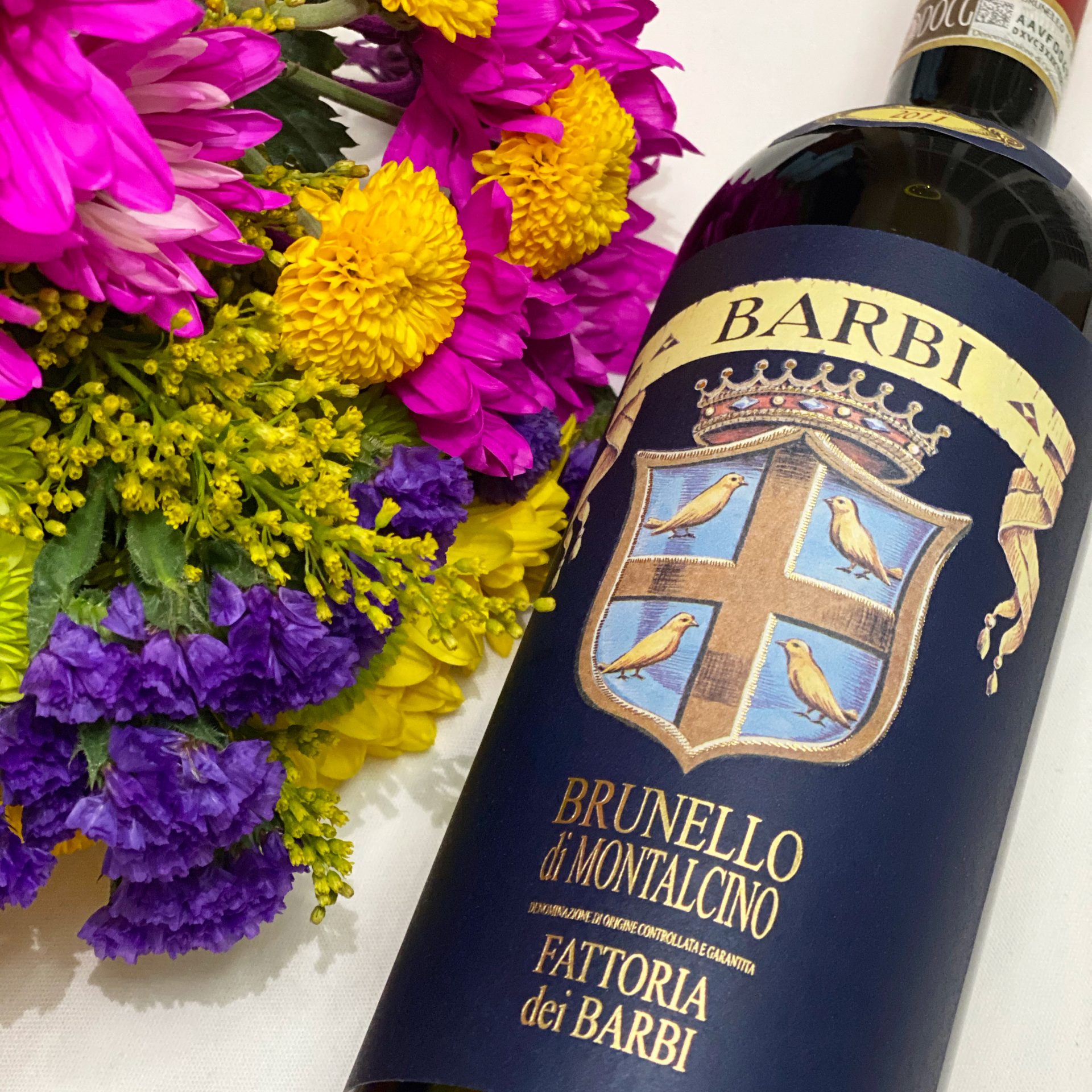
I’ve occasionally seen the red-label “riserva” wine, but have not had the opportunity to try that one. As a “riserva” wine, it has greater aging potential. I don’t know about y’all, but I’m counting less and less on aging things and popping open the bottles to enjoy the moment. At almost ten years old (when I like to drink Brunello), this was still the most structured and powerful wine of the night. Dark cherry and black plum, graphite, cedar and structured powdery tannins, it’s everything I love about a classic Brunello.
Well what can I say? Talk about an absolute gem of a virtual wine dinner. One of the things I really loved about the tasting and was amazed by (aside from all of Stefano’s stories), is that Sangiovese can make such a wide range of wines. Fattoria dei Barbi even makes a Vin Santo dessert wine with Sangiovese. I certainly look forward to when I can hop on a plane to visit to see the famous historic cellars, eat at their famous Taverna dei Barbi restaurant, and taste the wines amongst the vines. Until then, I’ll travel through my glass. Cheers.

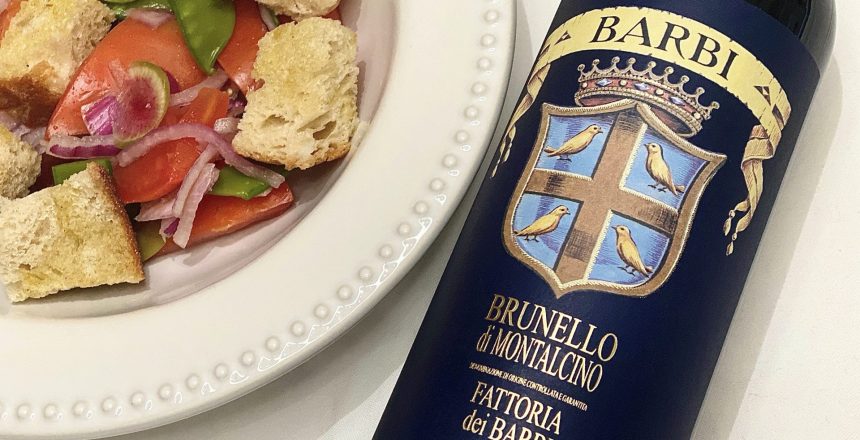
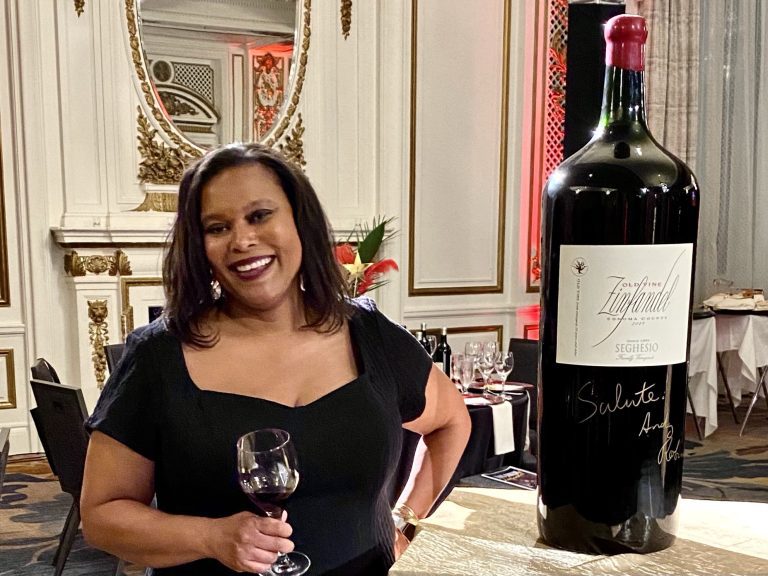
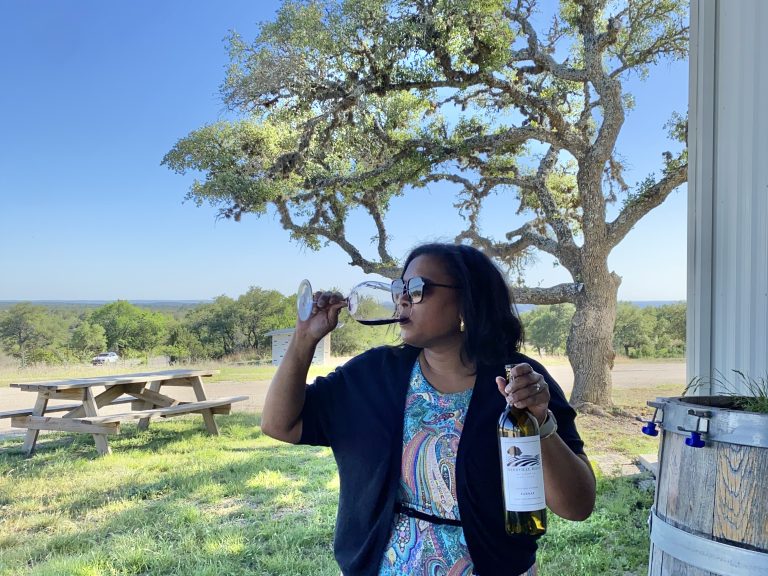
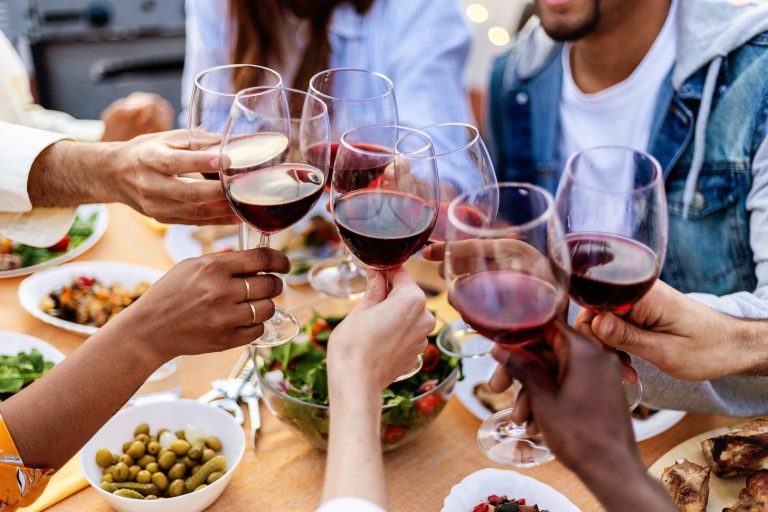

2 Comments
Jeremy Parzen
•3 years ago
Kat, thank you for this wonderful post. That was one of our most special dinners. Let’s make a pact to taste with our families at Barbi! Thanks for being part of such a memorable virtual wine dinner. Thank you!
Kat
•3 years ago
We are in! I’m so overdue for a wine trip to Italy!